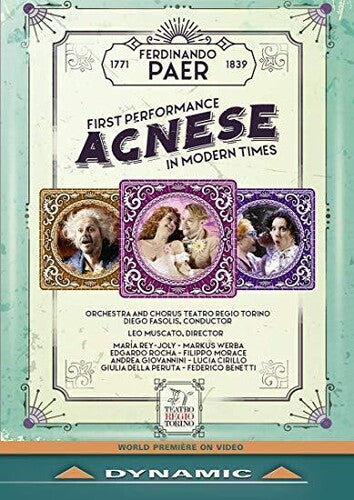FYE
Agnese
Agnese
Usually ships within 1 to 2 weeks.
Couldn't load pickup availability
SKU:DNMC37850DVD
Share
Parma native Ferdinando Paer, who wrote more than 50 operas, composed Agnese in 1809 for a private entertainment and a company of amateur singers. In 1824, with a few changes to the score, this opera semiseria in two acts reached the Theathre- Italien in Paris where it gained international success; among it's early admirers were Berlioz, Chopin and Victor Hugo who mentioned it in his Les Misérables but a few decades after it's première it fell into oblivion. In modern times it was first revived in concert form by Conductor Diego Fasolis and finally, in 2019 with the addition of a critical revision, it was performed at the Teatro Regio di Torino. The plot presents several fairy-tale elements, which are very well realized through the stage setting. When Agnese elopes with her beloved Ernesto, her father Uberto loses his mind and believes her dead. He is therefore hospitalized into a mental institution, where most of the action takes place. In the Ospedale dei pazzi sympathetic doctors, security guards and administrators try to help Uberto regain his sanity, to no avail. In the meanwhile, Agnese, betrayed and abandoned by Ernesto, to whom she bore a daughter, goes back to her father to ask for forgiveness, unaware of his troubles. Ernesto is repentant of his philandering ways and follows Agnese to win her back. The opera ends with Uberto regaining his mental clarity when he hears Agnese sing an old song, and a general reconciliation occurs. In director Leo Muscato's words "the most interesting aspect of this opera... is the irony that is present from the beginning to the end of the story" which imbues even the most dramatic circumstances. The set design for this wonderful, world premiere on video opera, is made of a series of movable boxes which are similar to carillons and which open-up displaying different environments.



